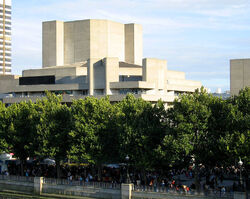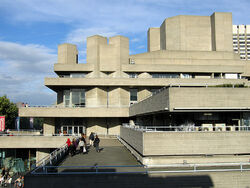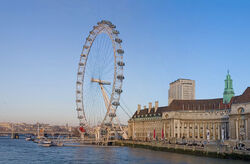| DISTRICT | ||
| South Bank | ||
|---|---|---|
| Image | {{{image}}} | |
| Population | ||
| PostCode District | ||
| Borough | Lambeth Southwark | |
| OS Grid Reference | ||
| Latitude | ||
| Longditude | ||

The National Theatre is one of the collection of arts buildings on the South Bank. The London Television Centre tower can be glimpsed at left.

A later example of Brutalist architecture, the appearance of the National Theatre remains controversial, and it was once likened to a "nuclear power station" by Prince Charles.
The South Bank is the area in London on the southern bank of the River Thames near Waterloo Station that houses a number of important cultural buildings/institutions. The South Bank stretches 2 square miles (5 square kilometres) along the shores of the River Thames. It was the site of the 1951 Festival of Britain, which proposed the name for this post-war urban regeneration project; the ancient name of the area is Lambeth Marsh and Lower Marsh. Presently it is London's fastest-growing section, a locale of modern cultural centre with numerous theatre, gallery, and concert halls. The legacy of the Festival is the Royal Festival Hall, now part of Southbank Centre arts complex. The area is split between the boroughs of Lambeth and Southwark (for the part of the riverside which stretches towards Blackfriars Bridge; the riverside beyond that point is properly Bankside.)
Since then, the Queen Elizabeth Hall and Purcell Room were opened in 1967 (on the site of a former Shot Tower), The Hayward in 1968, and the National Theatre in 1976. Nearby are the National Film Theatre and the BFI IMAX cinema. King's College London has a campus in the centre.
Adjacent to the National Theatre is the distinctive white tower of the London Weekend Television (LWT) building, where (among other things) the long-running television Arts programme The South Bank Show is produced. Carlton Television and GMTV have also broadcast from the building since 1993, and it is now called The London Television Centre.
Much of the area was subject to various large scale commercial development plans in the 1970s–1980s, which were successfully opposed by community groups. The renovation of the Oxo Tower and development of mixed housing developments and open space by community groups have encouraged the regeneration of the community in the area.

The London Eye on the South Bank
To the west of the RFH, beyond the railway viaduct leading up to Hungerford Bridge, is a public open space called Jubilee Gardens, separating it from nearby County Hall (Incidentally, the County Hall now houses a hotel — the Marriott London County Hall). By County Hall is the large Ferris wheel built to celebrate the 2000 Millennium, the London Eye.
To the east of the South Bank is the adjoining area of Bankside, deriving its name from one of the medieval causeways built to hold back the Thames. Bankside is home to the Tate Modern art gallery and the reproduction of Shakespeare's Globe Theatre and, near London Bridge, Borough Market.
Beyond Waterloo Station, to the south, can be found the rest of the Waterloo area, including the historic market street of Lower Marsh and The Cut, home of The Old Vic.
The South Bank is also regarded by many to be the unofficial home of British street skateboarding. The sheltered section beneath the Queen Elizabeth Hall has provided the skateboarding community of Britain and international skaters alike with ideal banks and stairs since the 1970s, and is conveniently located near other skatespots such as The Hayward. More recently, a skateboarding related art company, The Side Effects of Urethane, has provided Southbank Centre with several skatable sculptures in their 'Moving Units' project.
In September 2007, a statue of Sir Laurence Olivier as Hamlet was unveiled outside the National Theatre, to mark the great actor's centenary.
The Wikipedia page is [1].
The Southbank Centre website is [2].